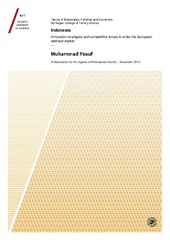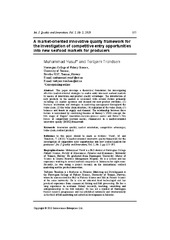| dc.contributor.advisor | Trondsen, Torbjørn | |
| dc.contributor.author | Yusuf, Muhammad | |
| dc.date.accessioned | 2014-04-03T08:39:15Z | |
| dc.date.available | 2014-04-03T08:39:15Z | |
| dc.date.issued | 2014-03-20 | |
| dc.description.abstract | Aims – This thesis examines the capabilities of the Indonesian seafood export industry to enter the European market, which is the world’s largest seafood importer. The aim is to offer a knowledge-based competitive marketing strategy which is analysed in four parts: Paper I: Competitive framework; Paper II: Legal barriers; Paper III: Demand for seafood trade innovation in Europe; Paper IV: The Indonesian supply advantage.
Focus of study – Fisheries has the potential to become a leading contributor to Indonesia’s economic development. This case study examines empirically the export potential of the European (EU) market for Indonesian Blue Swimming Crab (BSC), which currently depends on the United States (US) market. The main research question is: What are the strengths and the potential barriers for introduction and export of Indonesian seafood like BSC into the European market? What are the key factors for improving the competitiveness and value chain effectiveness for Indonesian exporters entering the new European market?
Theory, methodology and findings – The main argument in this thesis is that success in the introduction of new products into the European market relies on market oriented strategic management. Market orientation is defined as an industry-wide generation of market intelligence pertaining to current and future customer needs, the dissemination of that intelligence across the value chain, and industry-wide capability to response to it (Kohli and Jaworski, 1990; Grunert et al., 2010). This thesis investigates the information relevant to market intelligence and analyses required to uncover competitive strategic opportunities and barriers to entering new markets with new seafood products.
A combination of secondary and primary data is used in the investigation and analyses. Secondary data was collected from literature, statistics and legal databases while primary data was collected by surveys of European seafood buyers and Indonesian seafood suppliers.
In paper I, a framework for the collection and analysis of intelligence is developed to identify opportunities and barriers in the introduction of innovative seafood products in markets by combining marketing theories from Rogers (2003), Barney (2002) and Porter (1980; 2008). Seven major categories important for developing market oriented value chain product advantages and market introduction advantages are identified; (1) trade barrier regulation, (2) supply-demand balance in the actual market (3) consumers’ purchasing behaviour, (4) customers’ value chain control, (5) pressure from the raw material suppliers, (6) competitive pressure within the value chain from; investment in innovation performance, market oriented infrastructure, rivals and new entrants, and (7) competitive pressure of substitute products. Intelligence as data of strategic value may be revealed by identification of the offered market values, market rareness, imitation protection and organizational capabilities (the VRIO model) and the factors influencing market adoption of new products (see Paper III below). Some of the seven categories presented in paper I were empirically studied in papers II, III and IV (Chapter 5), and supported the investigation of market trends (Chapter 6).
Paper II studies legal regulation and trade barriers based on the sociology of law. The main finding is that the legal trade barriers are not among the main problems that explain the previous downturn in Indonesian exports to the EU. Nevertheless, the study indicates that Indonesia’s surveillance and enforcement of its domestic laws is in need of improvement. The challenge for Indonesia is to improve the legal framework; a challenge that seems most easily addressed by a full harmonization of Indonesian food safety rules to the EU law and the establishment of an EU-Indonesia conformity assessment agreement. The finding emphasizes the importance of gathering information on the law regarding trade barriers early in the process of market entry.
Paper III analyses the importance of marketing-strategic intelligence combining product, price, promotion and place (the 4Ps) relative to the purchaser’s process of decision-making for the adoption of new seafood products in the EU market: the relative advantage, compatibility with current industry conventions, complexity of use, trialability in the small scale and social observability (the 5 IDs). The findings showed significant interest in new seafood products in the studied distribution chains. Nevertheless, the adoption process for new products meets many hurdles have to be overcome. The findings show the importance of intelligence about the process of adoption of innovative products which goes through two decision stages: the decision takers focus, in the first stage, on 5 ID product properties, while in the second stage they focus on the relative advantages (value for money) in the product-price relationship. This finding is important for the stepwise design of the process of market intelligence collection and 4P strategies in the introduction of new products.
Paper IV studies the competitive strength of the Indonesian crab industry in light of the seven competitive factors presented in Paper I. The findings suggest that the Indonesian crab industry is able to supply first-class crab products. Nevertheless, its competitiveness is hampered by lack of investment in effective development of market orientated innovative products. The findings further disclose the industry’s low capability of competitive rivalry and protection, both against domestic and foreign competitors. The industry has a need for orientation of the innovation in value chain and industrial strategies towards Europe as the target market based on up to date market intelligence.
In sum this study suggests that Indonesian seafood industries have the potential for competitive export to the EU market due to its strength in factors such as: (1) adequate supply of raw materials; (2) capability in infrastructure; and (3) industrial experience from exporting competitive generic products to the US market. However, the analysis indicates that the Indonesian capability for market orientation and innovation will face challenges in developing long-term market oriented strategies that it are important to address in order to gain competitive advantages.
Managerial implications – This thesis offers a conceptual framework for gathering intelligence and analysis of competitive market-oriented strategies of seafood value chains in a national and international perspective as well as an analysis of the current competitive capability of the Indonesian seafood industry. This comprehensive framework can be applied in further research as a tool for analysis of competitive forces. The framework may also support the decision makers’ evaluation of the market-oriented value chain strategy and the industrial environment. | en |
| dc.description.doctoraltype | ph.d. | en |
| dc.description.popularabstract | Denne avhandlingen undersøker mulighetene i den indonesiske sjømateksportindustrien på det europeiske markedet, som er verdens største sjømatimportør. Målet er å tilby en kunnskapsbasert og konkurransedyktig markedsføringsstrategi som er analysert i fire deler: Artikkel I: Konkurransedyktig rammeverk; Artikkel II: Juridiske barrierer; Artikkel III: Behovet for innovasjon i europeisk sjømathandel; Artikkel IV: Indonesiske konkurransefortrinn og innovasjonsstrategier.
I sum antyder denne studien at den indonesiske sjømatindustrien har potensial for konkurransedyktig eksport til EU-markedet på grunn av faktorer som: (1) tilstrekkelig tilførsel av råvarer, (2) god infrastruktur, og (3) industriell erfaring fra eksport av konkurransedyktige generiske produkter til det amerikanske markedet. Imidlertid indikerer analysen at den indonesiske evne til markedsorientering og innovasjon vil møte utfordringer i å utvikle langsiktige markedsorienterte strategier som det er viktig å ta tak i for å oppnå konkurransefortrinn.
Denne avhandlingen gir et konseptuelt rammeverk for å samle kunnskap og analyse av konkurrerende markedsorienterte strategier for verdikjeder i et nasjonalt og internasjonalt perspektiv, samt en analyse av dagens konkurranseevne til den indonesiske sjømatnæringen. Dette omfattende rammeverket kan brukes i videre forskning som et verktøy for analyse av konkurrerende krefter. Rammeverket kan også støtte beslutningstakeres evaluering av den markedsorienterte verdikjedestrategien og av industrien. | en |
| dc.description | Papers 2,3 and 4 of this thesis are not available in Munin: <br/>2. Ørebech, P. and Yusuf, M.: '"Trade, not aid": How to conquer the EU market? Disguised trade barriers or exporter imperfections', (manuscript). <br/>3. Yusuf, M., Xie, J. and Trondsen, T.: 'Decision process for adoption of innovate products in the European seafood market: The importance of the supply and demand factors', (manuscript). <br/>4. Yusuf, M. and Trondsen, T.: 'Competitive forces and innovation strategies for entering new market: A study of Indonesian crab industries' (manuscript). | en |
| dc.identifier.isbn | 978-82-8266-073-0 | |
| dc.identifier.uri | https://hdl.handle.net/10037/6150 | |
| dc.identifier.urn | URN:NBN:no-uit_munin_5843 | |
| dc.language.iso | eng | en |
| dc.publisher | UiT Norges arktiske universitet | en |
| dc.publisher | UiT The Arctic University of Norway | en |
| dc.rights.accessRights | openAccess | |
| dc.rights.holder | Copyright 2014 The Author(s) | |
| dc.subject.courseID | DOKTOR-002 | en |
| dc.subject | VDP::Agriculture and fishery disciplines: 900::Fisheries science: 920::Other fisheries disciplines: 929 | en |
| dc.subject | VDP::Landbruks- og Fiskerifag: 900::Fiskerifag: 920::Andre fiskerifag: 929 | en |
| dc.title | Indonesia: Innovation strategies and competitive forces to enter the European seafood market | en |
| dc.type | Doctoral thesis | en |
| dc.type | Doktorgradsavhandling | en |


 English
English norsk
norsk
